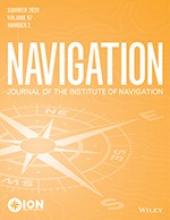Research ArticleOriginal Article
Open Access
Signal deformation fault monitors for dual-frequency GBAS
Junesol Song, Carl Milner and Ikhlas Selmi
NAVIGATION: Journal of the Institute of Navigation June 2020, 67 (2) 379-396; DOI: https://doi.org/10.1002/navi.360
Junesol Song
ENAC, Université de Toulouse, Toulouse, France
Carl Milner
ENAC, Université de Toulouse, Toulouse, France
Ikhlas Selmi
ENAC, Université de Toulouse, Toulouse, France

REFERENCES
- 1.↵ICAO Annex 10 to the Convention on International Civil Aviation, Vol. 1, Amendments 90; 2006.
- 2.↵ICAO Annex 10 to the Convention on International Civil Aviation, Vol. 1, Amendments 91; 2018.
- 3.↵
- ICAO SARPs
- 4.↵
- Shloss P,
- Phelts RE,
- Walter T,
- Enge P
- 5.↵
- Brenner M,
- Liu F
- 6.↵
- Daly P,
- Riley S,
- Raby P
- 7.↵
- Phelts RE
- 8.↵
- Liu F,
- Brenner M,
- Tang CY
- 9.↵
- Jiang Y,
- Milner C,
- Macabiau C
- 10.↵
- Song J,
- Milner C,
- Selmi I,
- Bouterfas S,
- Julien O
- 11.↵
- Pagot J-B
- 12.↵Baseline development standards for the validation of draft Annex 10, Volume I amendments relating to dual-frequency, multi-constellation(DFMC) SBAS, Appendix A to the Report on Agenda Item 2. 5th Meeting of the Navigation Systems Panel (NSP/5); 2018.
- 13.↵
- Shively CA
- 14.↵
- Zaugg T
- 15.↵
- Rife J,
- Phelts RE
- 16.↵
- SESAR
- 17.↵
- Simili DV,
- Pervan B
- 18.↵
- Hwang PY,
- McGraw GA,
- Bader JR
- 19.↵
- Pervan B,
- Khanafseh S,
- Patel J
- 20.↵
- EASA., CS AWO 1
- 21.↵
- FAA Advisory Circular 120-28D
- 22.↵Minimum operational performance standards (MOPS) for GPS local area augmentation system airborne equipment, RTCA DO-253C. Washington, DC; 2008.
- 23.↵
- Milner C,
- Guilbert A,
- Macabiau C
- 24.↵
- Julien O,
- Selmi I,
- Pagot J-B,
- Samson J,
- Fernandez FA
In this issue
NAVIGATION: Journal of the Institute of Navigation
Vol. 67, Issue 2
Summer 2020
Signal deformation fault monitors for dual-frequency GBAS
Junesol Song, Carl Milner, Ikhlas Selmi
NAVIGATION: Journal of the Institute of Navigation Jun 2020, 67 (2) 379-396; DOI: 10.1002/navi.360
Jump to section
Related Articles
- No related articles found.
Cited By...
- No citing articles found.






